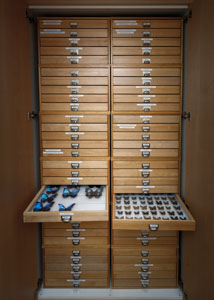AZ Lepidoptera

I have been collecting Lepidoptera at least since the age of 8. There were ups and downs, but I never fully quit this hobby. Except for a few gifts from friends, I only collect insects that I → capture myself in the wild. For this reason I like to think of myself as a hunter and trapper, not a collector (this is a good moment to read my → environmental statement). Right now my collection boasts 6703 unique cataloged specimens from 56 countries, representing 4566 subspecies of 3882 species in 1468 genera, as detailed in the complete → holdings list.


My collection no longer belongs to me. It has officially become part of the millions-strong → insect collection of my school ETHZ , in the Department of Environmental Systems Science. For now, I have it on loan in my house, where I can continue working on it in my free time. All specimens are stored pinned and dried in special drawers: almost airtight flat wooden boxes with a foamy bottom to hold the insect pins and a glass top. About 150 of these drawers fill up a dedicated room.
Each specimen has a unique ID tag and a digital counterpart. The latter is a pair of tagged photographs of the dorsal and ventral views of the set specimen. Additional photos and micrographs may also be included. Overall, this website contains 14102 high-resolution images. I started digitizing the collection back in 2000, when the first digital cameras became available. I had to restart twice, since the quality of the images they produced kept improving. I am still not done photographing everything to the latest standard. Initially the digital collection was a simple web site that I edited manually with a wysiwyg html editor. The effort collapsed around 2019: the collection became too large to be managed in that manner. The only solution was to learn Python and Javascript from scratch, and to write a proper database program, along with some code to generate all web pages and PDF files automatically. The result is what you are looking at now. All digital specimens are stored in "digital drawers" that you are invited to browse by clicking on them below.
Despite my efforts, this database surely contains erroneous ids and other mistakes. Please let me know if you find any. A few specimens remain entirely or partly → unidentified . I am at the end of my wits. If you could provide any help with these, it would be greatly appreciated. Also, please note that links to the GBIF database are generated automatically and may in a few cases be wrong.

























































